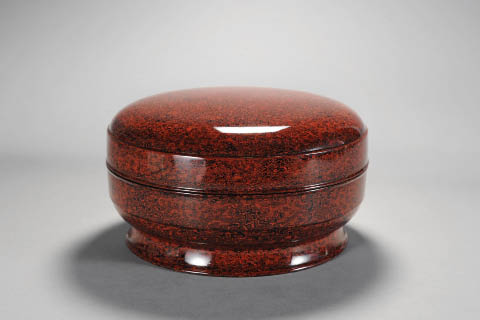Custodian of Huizhou’s Lacquer Art Traditions
By staff reporter JIAO FENG
GAN Erke was born in 1955 in Huangshan, Anhui Province. Today, Gan has considerable expertise in painting, carpentry, carving, and traditional lacquer techniques. Over the last three decades he has been instrumental in revitalizing the Huizhou “pineapple lacquer” tradition. Gan has also played an important role in bringing a local strand of lacquer inkslab art back from the brink of extinction.
 |
|
Pineapple lacquer bodiless round box made by Gan Erke. |
In 2006, Gan Erke was awarded the title of “inheritor of Huizhou lacquer art,” which is recognized as a Chinese intangible cultural heritage. The year 2011 saw Gan’s Red Inlaid Gold Pineapple Lacquer Round Box enter the Palace Museum collection in Beijing.
Huizhou in southern Anhui Province was historically an economic and cultural hub. Raw lacquer was especially abundant in Huizhou thanks to a local tree species called Anacardiaceae (“Lacquer Tree” colloquially).
Lacquerware in China dates back to the 13th century B.C. As a natural chemical material, raw lacquer used as a finish can resist humidity, high temperatures and erosion. The application process also results in the lacquer acquiring a mixture of colors, meaning the material has artistic, as well as practical value.
Chinese lacquer art was refined considerably in the period between the 10th century and 19th century. Many places in China became famous for their lacquer art, including Beijing, and Anhui, Guangdong, Fujian, Jiangsu and Shanxi provinces. During the period lacquer techniques also spread to Japan and Southeast Asia, greatly influencing folk arts and crafts in those places.
Gan Erke was born into an ordinary family in Tunxi District of Huangshan City. After graduating from junior middle school, he began his study of carpentry, painting and carving. Among his first jobs was fashioning wooden formers for a local lumber mill.
A subsequent decade spent as a carpenter afforded Gan a solid foundation in design and carving. In 1979, the 24-year-old Gan was admitted to the Tunxi Lacquerware Arts and Crafts Factory, where he studied as an apprentice to old masters. With his painting background and natural talent, he quickly made a name for himself in carving and was sent to Shanghai to study lacquer art the following year.
After finishing his studies in Shanghai, Gan Erke returned home and was promoted to director of the lacquer carving crafts workshop. He met and maintained close contact with Tunxi lacquerware artist Yu Jinhai, well known expert in the ancient lacquer techniques of the State of Chu of the Warring States Period (475-221 BC). Gan’s commitment to his art impressed Yu, who invested his time in teaching the young prodigy vital lacquer skills and techniques. The two worked together on many pieces.
In 1985 Gan was transferred to the Tunxi Arts and Crafts Institute and began studying more complicated lacquerware techniques. The creation of regular lacquerware involves applying lacquer finish over wood, leather or metal bodies. But at the Tunxi Institute Gan learned the more difficult process of making “bodiless” lacquerware – applying lacquer over clay or parget shells, which would then be removed to leave a work of pure lacquer.
At the institute, Gan widened his understanding of the craft through acquaintances with a variety of specialists representing many different lacquer traditions. He developed a masterly command of all stages of lacquer art creation, including design, carving and polishing.

